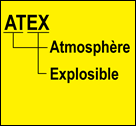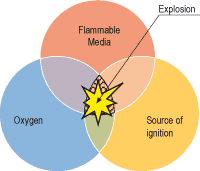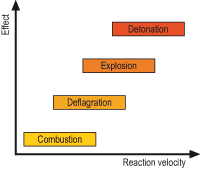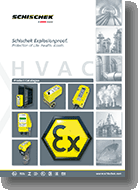
|
|
Dear Visitor, |
|
|
Explosion protection is a complex topic that always deals with great responsibility, with safety for life, health and assets. We want to provide you with information and facts and, of course, also with products and solutions – so that you will feel at ease to plan, construct and operate safe systems according to ATEX. |
||
Regulations for explosion protection according to ATEX directivesSince July 01, 2003 the rules of explosion protection in the EU are set out by ATEX directive 94/9/EC (as of April 20, 2016: ATEX 2014/34/EU) concerning equipment and protective systems for use in potentially explosive atmospheres. The aim was to replace national provisions in favor of uniform EU-wide rules and regulations to establish uniform safety standards and to eliminate barriers to trade. In 1996, directive 94/9/EC (as of April 20, 2016: 2014/34/EU) was transposed into German law by the German Equipment Safety Act (recast: Product Safety Act) and the Act on Explosion Protection, in short ExVO (11th GPSGV). While directive 94/9/EC (as of April 20, 2016: 2014/34/EU) defines construction requirements, i.e. it is of particular interest to manufacturers of explosion-proof equipment, operators of installations have to observe directive 1999/92/EC for the safety of workers endangered by explosive atmospheres. In Germany, this directive is transposed into German law by the Industrial Safety and Health Act (BetrSichV).On April 20, 2016, the ATEX directive 94/9/EC has been replaced by the new directive 2014/34/EU. Many changes in the new directive are not relevant for manufacturers of explosion-proof equipment.Most of the essential content remains the same, for example, Annex I "Criteria determining the classification of equipment-groups into categories" and the essential health and safety requirements (EHSR; Annex II) of the directive do not change. Important for both manufacturers as well as operators and plant manufacturers is that EC-type examination certificates issued in accordance with directive 94/9/EC are still valid. A recertification according to directive 2014/34/EU is therefore not required. ExVODirective on the distribution of equipment and protection systems for potentially explosive areas – explosion protection prescription 11.GSGV.Ordinance on Industrial Safety and HealthOrdinance concerning the protection of safety and health in the provision of work equipment and its use at work, concerning safety when operating installations subject to monitoring and concerning the organization of industrial safety and health at work.CertificatesCorresponding approvals and certificates are required for electrical explosion protected equipment. Testing must be carried out by an official testing agency (Notified Body, for example the PTB - Physikalisch Technische Bundesanstalt in Braunschweig/Federal German Physical and Technical Institute in Braunschweig). ATEX approvals are also accepted in many countries and states outside Europe.ResponsibilitiesThe responsibility for compliance with all regulations and directives, from production and planning to installation, operation and maintenance, has greatly increased.Each individual must be clear on the fact that he accepts personal responsibility as part of an overall project: |
||
|
- building owners - end-users - architects - consulting engineers - control companys - inspection authoritys - contractors/installers - manufacturers - product suppliers - maintenance engineers |
 |
|
This has far-reaching consequences on the selection, installation, operation and maintenance of equipment within explosive atmospheres. For the first time, not only electrical equipment is subjected to a critical examination of potential explosion risks, but also mechanical, pneumatic and hydraulic devices and components. This includes, amongst others, mechanical drives and clutches, pneumatic actuators and sensors, flange couplings as well as other plant components that were classified as being uncritical so far.
|
||
When does the danger of an explosion occur?A danger of explosion occurs when a flammable medium (gas, vapor, mist or dust) is present in a dangerous quantity.When does an explosion occur?An explosion may occur when the following3 components are present at the same time: - Flammable or combustible media - Oxygen - Source of ignition |
 |
|
Typical sources of ignitionVery often the cause of an accident is self-ignition, hot surfaces and mechanically generated sparks. But there are also a lot of other sources of ignition, caused by either mechanical and/or electrical equipment:Self-ignition, extraordinary surface temperatures, open flames, sparks caused by mechanical reasons, static electricity, lightning strike, ultra-sound, chemical sources of ignition... |
||
From combustion to detonationEffect and reaction velocity increase significantly from combustion, deflagration, via explosion up to detonation. Explosions are more likely with gaseous media and detonations with dust media. |
 |
|




